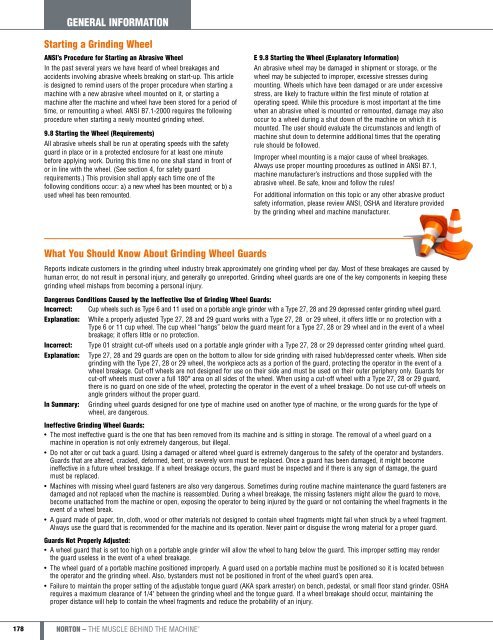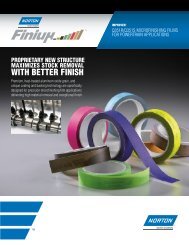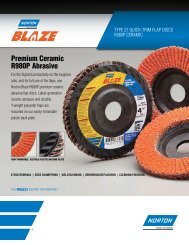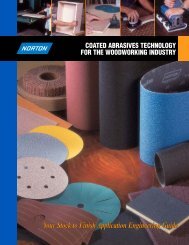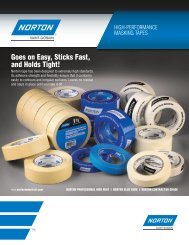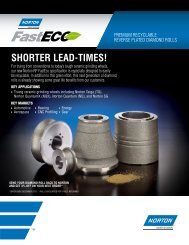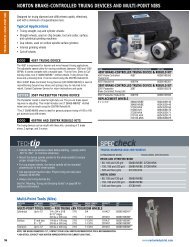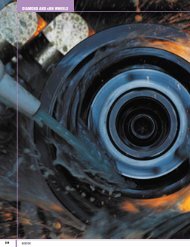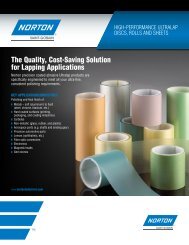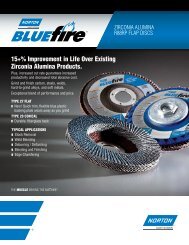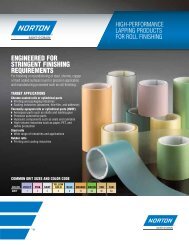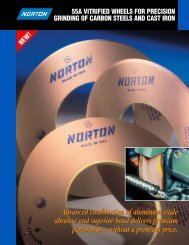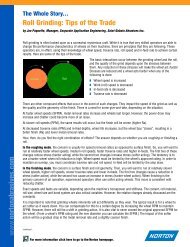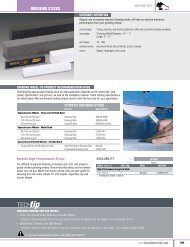Create successful ePaper yourself
Turn your PDF publications into a flip-book with our unique Google optimized e-Paper software.
General Information<br />
Starting a Grinding Wheel<br />
ANSI’s Procedure for Starting an Abrasive Wheel<br />
In the past several years we have heard of wheel breakages and<br />
accidents involving abrasive wheels breaking on start-up. This article<br />
is designed to remind users of the proper procedure when starting a<br />
machine with a new abrasive wheel mounted on it, or starting a<br />
machine after the machine and wheel have been stored for a period of<br />
time, or remounting a wheel. ANSI B7.1-2000 requires the following<br />
procedure when starting a newly mounted grinding wheel.<br />
9.8 Starting the Wheel (Requirements)<br />
All abrasive wheels shall be run at operating speeds with the safety<br />
guard in place or in a protected enclosure for at least one minute<br />
before applying work. During this time no one shall stand in front of<br />
or in line with the wheel. (See section 4, for safety guard<br />
requirements.) This provision shall apply each time one of the<br />
following conditions occur: a) a new wheel has been mounted; or b) a<br />
used wheel has been remounted.<br />
E 9.8 Starting the Wheel (Explanatory Information)<br />
An abrasive wheel may be damaged in shipment or storage, or the<br />
wheel may be subjected to improper, excessive stresses during<br />
mounting. Wheels which have been damaged or are under excessive<br />
stress, are likely to fracture within the first minute of rotation at<br />
operating speed. While this procedure is most important at the time<br />
when an abrasive wheel is mounted or remounted, damage may also<br />
occur to a wheel during a shut down of the machine on which it is<br />
mounted. The user should evaluate the circumstances and length of<br />
machine shut down to determine additional times that the operating<br />
rule should be followed.<br />
Improper wheel mounting is a major cause of wheel breakages.<br />
Always use proper mounting procedures as outlined in ANSI B7.1,<br />
machine manufacturer’s instructions and those supplied with the<br />
abrasive wheel. Be safe, know and follow the rules!<br />
For additional information on this topic or any other abrasive product<br />
safety information, please review ANSI, OSHA and literature provided<br />
by the grinding wheel and machine manufacturer.<br />
What You Should Know About Grinding Wheel Guards<br />
Reports indicate customers in the grinding wheel industry break approximately one grinding wheel per day. Most of these breakages are caused by<br />
human error, do not result in personal injury, and generally go unreported. Grinding wheel guards are one of the key components in keeping these<br />
grinding wheel mishaps from becoming a personal injury.<br />
Dangerous Conditions Caused by the Ineffective Use of Grinding Wheel Guards:<br />
Incorrect: Cup wheels such as Type 6 and 11 used on a portable angle grinder with a Type 27, 28 and 29 depressed center grinding wheel guard.<br />
Explanation: While a properly adjusted Type 27, 28 and 29 guard works with a Type 27, 28 or 29 wheel, it offers little or no protection with a<br />
Type 6 or 11 cup wheel. The cup wheel “hangs” below the guard meant for a Type 27, 28 or 29 wheel and in the event of a wheel<br />
breakage; it offers little or no protection.<br />
Incorrect: Type 01 straight cut-off wheels used on a portable angle grinder with a Type 27, 28 or 29 depressed center grinding wheel guard.<br />
Explanation: Type 27, 28 and 29 guards are open on the bottom to allow for side grinding with raised hub/depressed center wheels. When side<br />
grinding with the Type 27, 28 or 29 wheel, the workpiece acts as a portion of the guard, protecting the operator in the event of a<br />
wheel breakage. Cut-off wheels are not designed for use on their side and must be used on their outer periphery only. Guards for<br />
cut-off wheels must cover a full 180° area on all sides of the wheel. When using a cut-off wheel with a Type 27, 28 or 29 guard,<br />
there is no guard on one side of the wheel, protecting the operator in the event of a wheel breakage. Do not use cut-off wheels on<br />
angle grinders without the proper guard.<br />
In Summary: Grinding wheel guards designed for one type of machine used on another type of machine, or the wrong guards for the type of<br />
wheel, are dangerous.<br />
Ineffective Grinding Wheel Guards:<br />
• The most ineffective guard is the one that has been removed from its machine and is sitting in storage. The removal of a wheel guard on a<br />
machine in operation is not only extremely dangerous, but illegal.<br />
• Do not alter or cut back a guard. Using a damaged or altered wheel guard is extremely dangerous to the safety of the operator and bystanders.<br />
Guards that are altered, cracked, deformed, bent, or severely worn must be replaced. Once a guard has been damaged, it might become<br />
ineffective in a future wheel breakage. If a wheel breakage occurs, the guard must be inspected and if there is any sign of damage, the guard<br />
must be replaced.<br />
• Machines with missing wheel guard fasteners are also very dangerous. Sometimes during routine machine maintenance the guard fasteners are<br />
damaged and not replaced when the machine is reassembled. During a wheel breakage, the missing fasteners might allow the guard to move,<br />
become unattached from the machine or open, exposing the operator to being injured by the guard or not containing the wheel fragments in the<br />
event of a wheel break.<br />
• A guard made of paper, tin, cloth, wood or other materials not designed to contain wheel fragments might fail when struck by a wheel fragment.<br />
Always use the guard that is recommended for the machine and its operation. Never paint or disguise the wrong material for a proper guard.<br />
Guards Not Properly Adjusted:<br />
• A wheel guard that is set too high on a portable angle grinder will allow the wheel to hang below the guard. This improper setting may render<br />
the guard useless in the event of a wheel breakage.<br />
• The wheel guard of a portable machine positioned improperly. A guard used on a portable machine must be positioned so it is located between<br />
the operator and the grinding wheel. Also, bystanders must not be positioned in front of the wheel guard’s open area.<br />
• Failure to maintain the proper setting of the adjustable tongue guard (AKA spark arrester) on bench, pedestal, or small floor stand grinder. OSHA<br />
requires a maximum clearance of 1/4" between the grinding wheel and the tongue guard. If a wheel breakage should occur, maintaining the<br />
proper distance will help to contain the wheel fragments and reduce the probability of an injury.<br />
178 NORTON – THE MUSCLE BEHIND THE MACHINE ®


